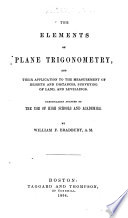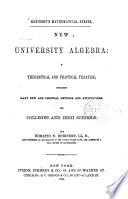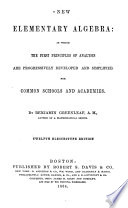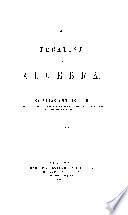 ... the product of the two, plus the square of the second. In the third case, we have (a + b) (a — 6) = a2 — b2. (3) That is, the product of the sum and difference of two quantities is equal to the difference of their squares. ... the product of the two, plus the square of the second. In the third case, we have (a + b) (a — 6) = a2 — b2. (3) That is, the product of the sum and difference of two quantities is equal to the difference of their squares.  A Treatise on Algebra - Page 189by Elias Loomis - 1846 - 346 pagesFull view A Treatise on Algebra - Page 189by Elias Loomis - 1846 - 346 pagesFull view - About this book
 | William Frothingham Bradbury - Plane trigonometry - 1864 - 324 pages
...B D2 ; 2o and AD= /4a'c'4 a1 __ BC X AD _ a /4a'c> — a /4 "IV" _ Ucfc'— (c' + a' — 6')' 16 As the product of the sum and difference of two quantities is equal to the difference of their squares, we have 4a'c' — (c"+ a' — 6')' = (?™ — 0s + a' — 6']) X (2ac + [c1 + a'— 6']). But 2ac —... | |
 | Benjamin Greenleaf - Algebra - 1864 - 420 pages
...rationalize any binomial. Suppose the binomial to be rationalized to be in the form of \/ a ± \/ b. Then, since the product of the sum and difference of two...quantities is equal to the difference of their squares (Art. 90), we have (\/ a -\- \/ b) (\/ a — \/ b) = a — b, which is rational. That is, when the... | |
 | Charles William Hackley - Algebra - 1864 - 532 pages
...6 = 0, c=0, the proposed equation will become alto- • gether indeterminate. The numerator, being the product of the sum and difference of two quantities, is equal to the difference of their squares, to wit : № — (4«-}-4a<:)= — 4ог. We see, therefore, that Sa is a common factor to the numerator... | |
 | Horatio Nelson Robinson - Algebra - 1864 - 444 pages
...product of the first and second, plus the square of the second. III. O+&) (a— i)=a'— V Or, in words, The product of the sum and difference of two quantities is equal to the difference of their squares. By the aid of these formulas we are enabled to write the square of any binomial, or the product of... | |
 | Benjamin Greenleaf - Algebra - 1864 - 336 pages
...247, To rationalize a binomial surd containing only the square root. 1. Rationalize \/a + V^OPERATION. Since the product of the sum and — - difference of two quantities is equal V^~TV* to the difference of their squares y'a — \jb (Theo. III. Art. 78), we multiply the . ,—... | |
 | Paul Allen Towne - Algebra - 1865 - 314 pages
...— 2y)" and (a; — 4)2 when a; = 4, y = 1. 64. Since (x-\-y) (x — y) = a? — y3, it follows that The product of the sum and difference of two quantities is equal to the difference of their squares. EXAMPLES. 1. (a + 6) (a — 6) = a* — 6s. 2. (2a + 6) (2a — 6) = 4a" — 6". 3. O + 4) (a; —... | |
 | Joseph Ray - Algebra - 1866 - 420 pages
...4xy+y*. 3. (3x— 52)2=9x2— 3(te2+25z2 4. (a«— 3cx)2=a2zz— 6acz2+9c2z2. SO. Theorem III. — The product of the sum and difference of two quantities, is equal to the difference of their squares. Let a represent one of the quantities, and 6 a -f 6 the other. a —6 Then, aj-6= their sum, and a... | |
 | Joseph Ray - Algebra - 1852 - 422 pages
...(2x— j03=4 3. (3*— 52)2=9 4. (az — 3cx)-=a?z3— 6 ART. 8O. THEOREM III. — The product of tlie sum and difference of two quantities, is equal to the difference of their squares. Let a represent one of the quantities, and b the other ; then a+i=their sum, and a — 6=their difference.... | |
 | Elias Loomis - Algebra - 1868 - 386 pages
...equation taken with the cpntrary sign. If we multiply together the two values of x (observing that the product of the sum and difference of two quantities...equal to the difference of their squares), we obtain Thus, in the equation a: 2 — -10a?— — 16, the product of the two roots 8 and 2 is +16, which... | |
 | William Frothingham Bradbury - Algebra - 1868 - 264 pages
...y. Ans. a;2 — 2xy-\-y2. 2. 2x — ±y. 3. x—1. Ans. a;2 — 2a:+ 1. 4. lx — 2. THEOREM IV. 60t The product of the sum and difference of two quantities is equal to the difference of their squares. Let a -\- b be the sum, and a — b the difference of the two quantities a and b. PROOF. a + b a —b... | |
| |